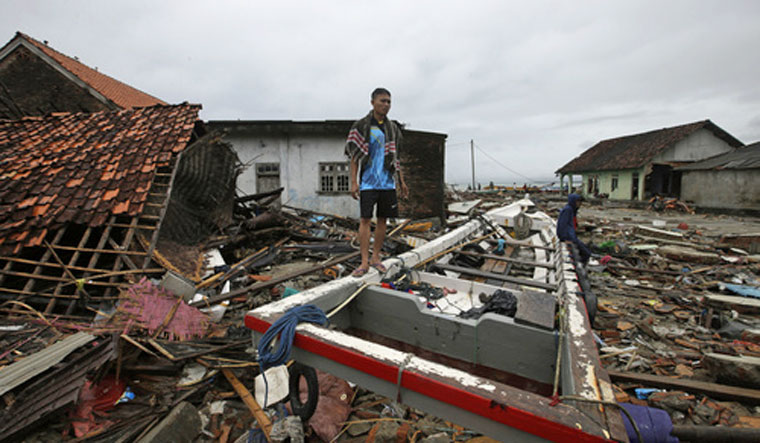In what has been the most disastrous tsunami Indonesia has seen yet, more than 373 people have been declared dead. According to humanitarian workers, clean water and medicine supplies were dwindling as thousands crammed makeshift evacuation centres. Even as aid flows into the country, fear of a public health crisis looms among survivors.
"A lot of the children are sick with fevers, headaches and they haven't had enough water," said Rizal Alimin, a doctor working for NGO Aksi Cepat Tanggap, at a local school that was turned into a temporary shelter. There is less medicine available, people are facing a food shortage and there is not enough bedding. According to experts, more deadly waves could strike the region, even as Carita reels under a tsunami that came without any warning.
Volunteers and aid workers have been scrambling to help stabilise the situation; but a lot of survivors who have fled to higher grounds cannot be reachable. Aid was flowing in mainly by road while two government boats were on their way to several islands near the Sumatran coast to help dozens of marooned residents.
Officials have said the evidence suggested that an eruption at the rumbling Anak Krakatoa volcano in the Sunda Strait — between Java and Sumatra — caused a section of the crater to collapse and slide into the ocean, triggering the tsunami. nlike those caused by earthquakes, which usually trigger alert systems, volcano-triggered tsunamis give authorities very little time to warn residents of the impending threat. People did not have enough time to evacuate.
While diggers and heavy equipment are being used to move debris and find corpses, many rescue workers are using their bare hands. This Tsunami also came less than a week before the 14th anniversary of the 2004 Boxing Day tsunami, one of the deadliest disasters in history that killed some 220,000 people in countries around the Indian Ocean, including some 168,000 Indonesians.
The vast archipelago nation is one of the most disaster-hit nations on Earth due to its position straddling the so-called Pacific Ring of Fire, where tectonic plates collide.
It is not a surprise that Christmas on the disaster-hit place has been very somber with very few turning up for prayer services.
Markus Taekz said his Rahmat Pentecostal Church in the hard-hit area of Carita did not celebrate with joyous music.
Instead, he said only about 100 people showed up for the Christmas Eve service, usually attended by double that number, because many people had left the area for the capital, Jakarta, or other areas away from the disaster zone.
"So our celebration is full of grief." Church leaders called on Christians across Indonesia, the world's most populous Muslim nation, to pray for victims of the tsunami.
Military troops, government personnel and volunteers were searching along debris-strewn beaches. Where victims were found, yellow, orange and black body bags were laid out, and weeping relatives identified the dead.
The waves followed an eruption and apparent landslide on Anak Krakatau, or "Child of Krakatoa," a volcanic island that formed in the early part of the 20th century near the site of the cataclysmic 1883 eruption of Krakatoa.
Hotels and hundreds of homes were heavily damaged by the waves. Chunks of broken concrete and splintered wood littered coastal areas.
Indonesian President Joko Widodo, who faces what promises to be a tough re-election campaign next year, vowed to have all tsunami-detection equipment replaced or repaired.
Sutopo Purwo Nugroho, spokesman for Indonesia Disaster Mitigation Agency, acknowledged on Twitter that the country's network of detection buoys had been out of order since 2012 because of vandalism and budget shortfalls.
The tsunami was probably caused by the collapse of a big section of the volcano's slope, said Gegar Prasetya, co-founder of the Tsunami Research Center Indonesia. Anak Krakatau been erupting since June and did so again 24 minutes before the tsunami, the geophysics agency said.


